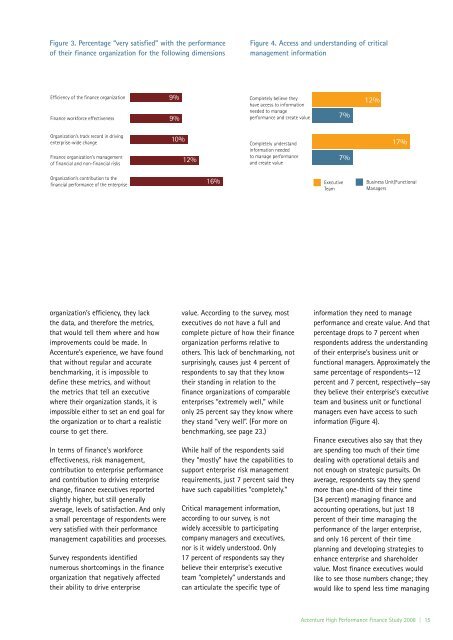The Changing Role of the Finance Organization in a Multi-Polar World
The Changing Role of the Finance Organization in a Multi-Polar World
The Changing Role of the Finance Organization in a Multi-Polar World
You also want an ePaper? Increase the reach of your titles
YUMPU automatically turns print PDFs into web optimized ePapers that Google loves.
Figure 3. Percentage “very satisfied” with <strong>the</strong> performance<br />
<strong>of</strong> <strong>the</strong>ir f<strong>in</strong>ance organization for <strong>the</strong> follow<strong>in</strong>g dimensions<br />
Efficiency <strong>of</strong> <strong>the</strong> f<strong>in</strong>ance organization<br />
<strong>F<strong>in</strong>ance</strong> workforce effectiveness<br />
<strong>Organization</strong>’s track record <strong>in</strong> driv<strong>in</strong>g<br />
enterprise-wide change<br />
<strong>F<strong>in</strong>ance</strong> organization’s management<br />
<strong>of</strong> f<strong>in</strong>ancial and non-f<strong>in</strong>ancial risks<br />
<strong>Organization</strong>’s contribution to <strong>the</strong><br />
f<strong>in</strong>ancial performance <strong>of</strong> <strong>the</strong> enterprise<br />
organization’s efficiency, <strong>the</strong>y lack<br />
<strong>the</strong> data, and <strong>the</strong>refore <strong>the</strong> metrics,<br />
that would tell <strong>the</strong>m where and how<br />
improvements could be made. In<br />
Accenture’s experience, we have found<br />
that without regular and accurate<br />
benchmark<strong>in</strong>g, it is impossible to<br />
def<strong>in</strong>e <strong>the</strong>se metrics, and without<br />
<strong>the</strong> metrics that tell an executive<br />
where <strong>the</strong>ir organization stands, it is<br />
impossible ei<strong>the</strong>r to set an end goal for<br />
<strong>the</strong> organization or to chart a realistic<br />
course to get <strong>the</strong>re.<br />
In terms <strong>of</strong> f<strong>in</strong>ance's workforce<br />
effectiveness, risk management,<br />
contribution to enterprise performance<br />
and contribution to driv<strong>in</strong>g enterprise<br />
change, f<strong>in</strong>ance executives reported<br />
slightly higher, but still generally<br />
average, levels <strong>of</strong> satisfaction. And only<br />
a small percentage <strong>of</strong> respondents were<br />
very satisfied with <strong>the</strong>ir performance<br />
management capabilities and processes.<br />
Survey respondents identified<br />
numerous shortcom<strong>in</strong>gs <strong>in</strong> <strong>the</strong> f<strong>in</strong>ance<br />
organization that negatively affected<br />
<strong>the</strong>ir ability to drive enterprise<br />
9%<br />
9%<br />
10%<br />
12%<br />
Completely believe <strong>the</strong>y<br />
have access to <strong>in</strong>formation<br />
needed to manage<br />
performance and create value<br />
Completely understand<br />
<strong>in</strong>formation needed<br />
to manage performance<br />
and create value<br />
16% Executive<br />
Team<br />
value. Accord<strong>in</strong>g to <strong>the</strong> survey, most<br />
executives do not have a full and<br />
complete picture <strong>of</strong> how <strong>the</strong>ir f<strong>in</strong>ance<br />
organization performs relative to<br />
o<strong>the</strong>rs. This lack <strong>of</strong> benchmark<strong>in</strong>g, not<br />
surpris<strong>in</strong>gly, causes just 4 percent <strong>of</strong><br />
respondents to say that <strong>the</strong>y know<br />
<strong>the</strong>ir stand<strong>in</strong>g <strong>in</strong> relation to <strong>the</strong><br />
f<strong>in</strong>ance organizations <strong>of</strong> comparable<br />
enterprises “extremely well,” while<br />
only 25 percent say <strong>the</strong>y know where<br />
<strong>the</strong>y stand “very well”. (For more on<br />
benchmark<strong>in</strong>g, see page 23.)<br />
While half <strong>of</strong> <strong>the</strong> respondents said<br />
<strong>the</strong>y “mostly” have <strong>the</strong> capabilities to<br />
support enterprise risk management<br />
requirements, just 7 percent said <strong>the</strong>y<br />
have such capabilities “completely.”<br />
Critical management <strong>in</strong>formation,<br />
accord<strong>in</strong>g to our survey, is not<br />
widely accessible to participat<strong>in</strong>g<br />
company managers and executives,<br />
nor is it widely understood. Only<br />
17 percent <strong>of</strong> respondents say <strong>the</strong>y<br />
believe <strong>the</strong>ir enterprise’s executive<br />
team “completely” understands and<br />
can articulate <strong>the</strong> specific type <strong>of</strong><br />
Figure 4. Access and understand<strong>in</strong>g <strong>of</strong> critical<br />
management <strong>in</strong>formation<br />
7%<br />
7%<br />
12%<br />
17%<br />
Bus<strong>in</strong>ess Unit/Functional<br />
Managers<br />
<strong>in</strong>formation <strong>the</strong>y need to manage<br />
performance and create value. And that<br />
percentage drops to 7 percent when<br />
respondents address <strong>the</strong> understand<strong>in</strong>g<br />
<strong>of</strong> <strong>the</strong>ir enterprise’s bus<strong>in</strong>ess unit or<br />
functional managers. Approximately <strong>the</strong><br />
same percentage <strong>of</strong> respondents—12<br />
percent and 7 percent, respectively—say<br />
<strong>the</strong>y believe <strong>the</strong>ir enterprise’s executive<br />
team and bus<strong>in</strong>ess unit or functional<br />
managers even have access to such<br />
<strong>in</strong>formation (Figure 4).<br />
<strong>F<strong>in</strong>ance</strong> executives also say that <strong>the</strong>y<br />
are spend<strong>in</strong>g too much <strong>of</strong> <strong>the</strong>ir time<br />
deal<strong>in</strong>g with operational details and<br />
not enough on strategic pursuits. On<br />
average, respondents say <strong>the</strong>y spend<br />
more than one-third <strong>of</strong> <strong>the</strong>ir time<br />
(34 percent) manag<strong>in</strong>g f<strong>in</strong>ance and<br />
account<strong>in</strong>g operations, but just 18<br />
percent <strong>of</strong> <strong>the</strong>ir time manag<strong>in</strong>g <strong>the</strong><br />
performance <strong>of</strong> <strong>the</strong> larger enterprise,<br />
and only 16 percent <strong>of</strong> <strong>the</strong>ir time<br />
plann<strong>in</strong>g and develop<strong>in</strong>g strategies to<br />
enhance enterprise and shareholder<br />
value. Most f<strong>in</strong>ance executives would<br />
like to see those numbers change; <strong>the</strong>y<br />
would like to spend less time manag<strong>in</strong>g<br />
Accenture High Performance <strong>F<strong>in</strong>ance</strong> Study 2008 | 15

















